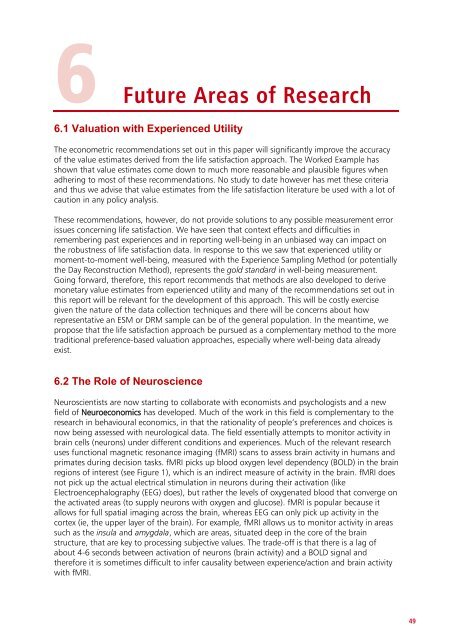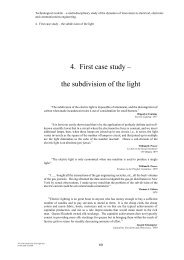Valuation Techniques for Social Cost-Benefit Analysis: - HM Treasury
Valuation Techniques for Social Cost-Benefit Analysis: - HM Treasury
Valuation Techniques for Social Cost-Benefit Analysis: - HM Treasury
You also want an ePaper? Increase the reach of your titles
YUMPU automatically turns print PDFs into web optimized ePapers that Google loves.
6 Future Areas of Research<br />
6.1 <strong>Valuation</strong> with Experienced Utility<br />
The econometric recommendations set out in this paper will significantly improve the accuracy<br />
of the value estimates derived from the life satisfaction approach. The Worked Example has<br />
shown that value estimates come down to much more reasonable and plausible figures when<br />
adhering to most of these recommendations. No study to date however has met these criteria<br />
and thus we advise that value estimates from the life satisfaction literature be used with a lot of<br />
caution in any policy analysis.<br />
These recommendations, however, do not provide solutions to any possible measurement error<br />
issues concerning life satisfaction. We have seen that context effects and difficulties in<br />
remembering past experiences and in reporting well-being in an unbiased way can impact on<br />
the robustness of life satisfaction data. In response to this we saw that experienced utility or<br />
moment-to-moment well-being, measured with the Experience Sampling Method (or potentially<br />
the Day Reconstruction Method), represents the gold standard in well-being measurement.<br />
Going <strong>for</strong>ward, there<strong>for</strong>e, this report recommends that methods are also developed to derive<br />
monetary value estimates from experienced utility and many of the recommendations set out in<br />
this report will be relevant <strong>for</strong> the development of this approach. This will be costly exercise<br />
given the nature of the data collection techniques and there will be concerns about how<br />
representative an ESM or DRM sample can be of the general population. In the meantime, we<br />
propose that the life satisfaction approach be pursued as a complementary method to the more<br />
traditional preference-based valuation approaches, especially where well-being data already<br />
exist.<br />
6.2 The Role of Neuroscience<br />
Neuroscientists are now starting to collaborate with economists and psychologists and a new<br />
field of Neuroeconomics has developed. Much of the work in this field is complementary to the<br />
research in behavioural economics, in that the rationality of people‘s preferences and choices is<br />
now being assessed with neurological data. The field essentially attempts to monitor activity in<br />
brain cells (neurons) under different conditions and experiences. Much of the relevant research<br />
uses functional magnetic resonance imaging (fMRI) scans to assess brain activity in humans and<br />
primates during decision tasks. fMRI picks up blood oxygen level dependency (BOLD) in the brain<br />
regions of interest (see Figure 1), which is an indirect measure of activity in the brain. fMRI does<br />
not pick up the actual electrical stimulation in neurons during their activation (like<br />
Electroencephalography (EEG) does), but rather the levels of oxygenated blood that converge on<br />
the activated areas (to supply neurons with oxygen and glucose). fMRI is popular because it<br />
allows <strong>for</strong> full spatial imaging across the brain, whereas EEG can only pick up activity in the<br />
cortex (ie, the upper layer of the brain). For example, fMRI allows us to monitor activity in areas<br />
such as the insula and amygdala, which are areas, situated deep in the core of the brain<br />
structure, that are key to processing subjective values. The trade-off is that there is a lag of<br />
about 4-6 seconds between activation of neurons (brain activity) and a BOLD signal and<br />
there<strong>for</strong>e it is sometimes difficult to infer causality between experience/action and brain activity<br />
with fMRI.<br />
49





![AIRTO [Professor Dr Brian Blunden] - HM Treasury](https://img.yumpu.com/15492848/1/184x260/airto-professor-dr-brian-blunden-hm-treasury.jpg?quality=85)










